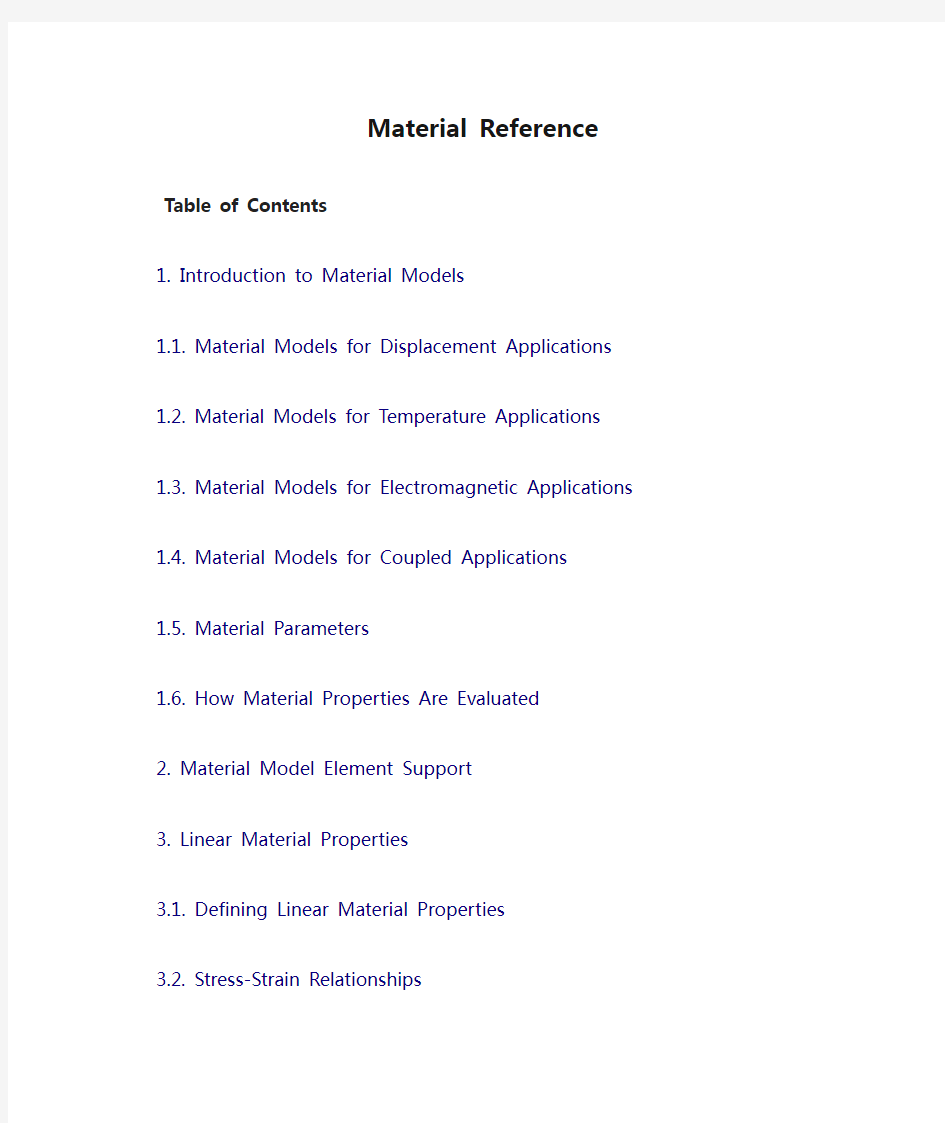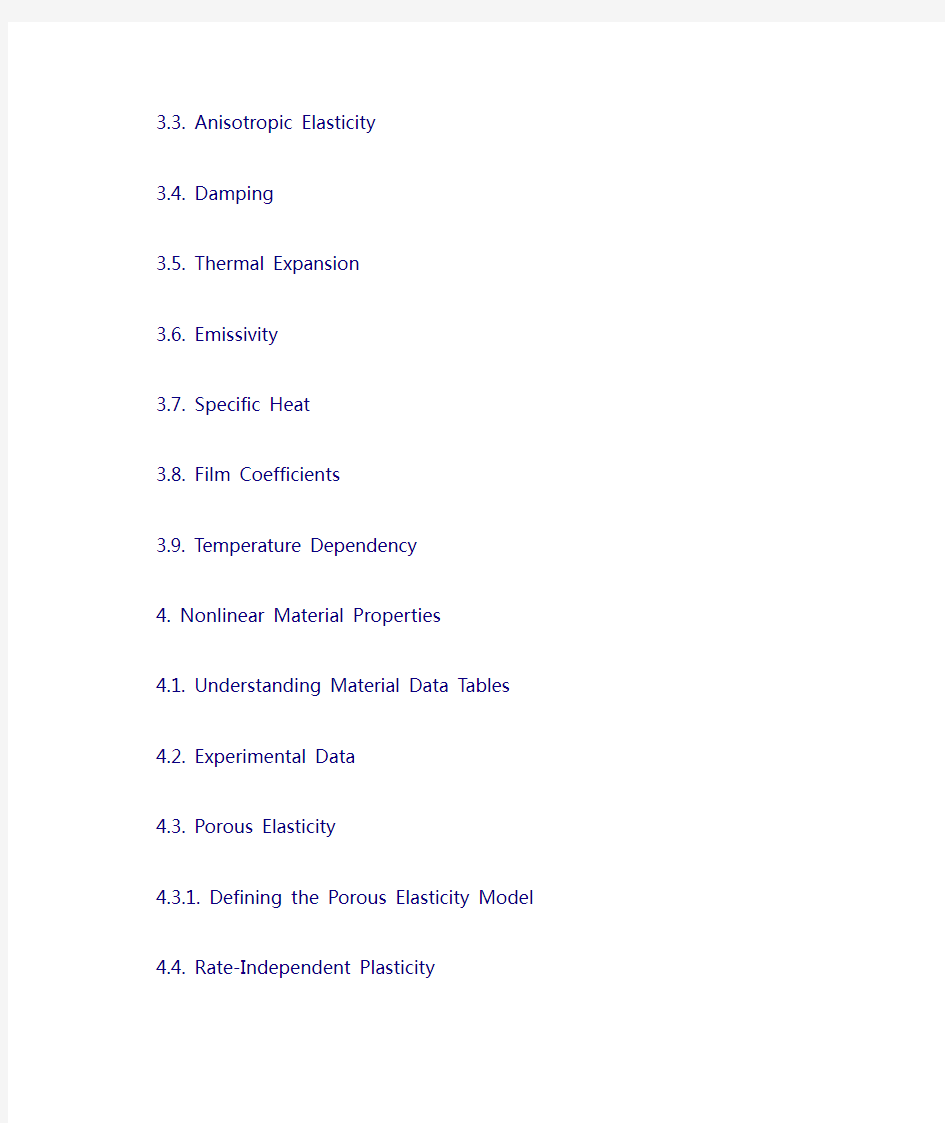

Material Reference
Table of Contents
1. Introduction to Material Models
1.1. Material Models for Displacement Applications
1.2. Material Models for Temperature Applications
1.3. Material Models for Electromagnetic Applications
1.4. Material Models for Coupled Applications
1.5. Material Parameters
1.6. How Material Properties Are Evaluated
2. Material Model Element Support
3. Linear Material Properties
3.1. Defining Linear Material Properties
3.2. Stress-Strain Relationships
3.3. Anisotropic Elasticity
3.4. Damping
3.5. Thermal Expansion
3.6. Emissivity
3.7. Specific Heat
3.8. Film Coefficients
3.9. Temperature Dependency
4. Nonlinear Material Properties
4.1. Understanding Material Data Tables
4.2. Experimental Data
4.3. Porous Elasticity
4.3.1. Defining the Porous Elasticity Model
4.4. Rate-Independent Plasticity
4.4.1. Understanding the Plasticity Models
4.4.2. Isotropic Hardening
4.4.3. Kinematic Hardening
4.4.4. Drucker-Prager
4.4.
5. Gurson
4.4.6. Cast Iron
4.5. Rate-Dependent Plasticity (Viscoplasticity)
4.5.1. Perzyna and Peirce Options
4.5.2. Exponential Visco-Hardening (EVH) Option
4.5.3. Anand Option
4.5.4. Defining Rate-Dependent Plasticity (Viscoplasticity)
4.5.5. Creep
4.6. Hyperelasticity
4.6.1. Arruda-Boyce Hyperelasticity
4.6.2. Blatz-Ko Foam Hyperelasticity
4.6.3. Extended Tube Hyperelasticity
4.6.4. Gent Hyperelasticity
4.6.
5. Mooney-Rivlin Hyperelasticity
4.6.6. Neo-Hookean Hyperelasticity
4.6.7. Ogden Hyperelasticity
4.6.8. Ogden Compressible Foam Hyperelasticity
4.6.9. Polynomial Form Hyperelasticity
4.6.10. Response Function Hyperelasticity
4.6.11. Yeoh Hyperelasticity
4.6.12. Special Hyperelasticity
4.7. Viscoelasticity
4.7.1. Viscoelastic Formulation
4.7.2. Time-Temperature Superposition
4.7.3. Harmonic Viscoelasticity
4.8. Microplane
4.8.1. Microplane Modeling
4.8.2. Microplane Material Models
4.8.3. Learning More About Microplane Material Modeling
4.9. Geomechanics
4.9.1. Understanding the Material Models for Geomechanics
4.9.2. Cam-clay
4.9.3. Mohr-Coulomb
4.9.4. Jointed Rock
4.9.
5. Drucker-Prager Concrete
4.9.6. Menetrey-Willam
4.10. Porous Media
4.10.1. Fluid Flow and Permeability
4.10.2. Porous Media Mechanics
4.10.3. Porous Media Material Properties
4.10.4. Thermal Material Properties
4.10.
5. Transient vs. Static Analysis
4.10.6. Partially Saturated Porous Media Flow and Coupled-Pore-Pressure-Thermal (CPT) Damping
4.10.7. Additional Resources
4.11. Gasket
4.12. Swelling
4.13. Shape Memory Alloy (SMA)
4.13.1. SMA Model for Superelasticity
4.13.2. SMA Material Model with Shape Memory Effect
4.13.3. Result Output of Solution Variables
4.13.4. Element Support for SMA
4.13.
5. Learning More About Shape Memory Alloy
4.14. MPC184 Joint
4.14.1. Linear Elastic Stiffness and Damping Behavior
4.14.2. Nonlinear Elastic Stiffness and Damping Behavior
4.14.3. Frictional Behavior
4.1
5. Contact Friction
4.1
5.1. Isotropic Friction
4.1
5.2. Orthotropic Friction
4.1
5.3. Redefining Friction Between Load Steps
4.1
5.4. User-Defined Friction
4.16. Contact Interaction
4.16.1. Interaction Options for General Contact Definitions
4.16.2. User-Defined Interaction
4.17. Cohesive Material Law
4.17.1. Exponential Cohesive Zone Material for Interface Elements and
Contact Elements
4.17.2. Bilinear Cohesive Zone Material for Interface Elements and
Contact Elements
4.17.3. Viscous Regularization of Cohesive Zone Material for Interface
Elements and Contact Elements
4.17.4. Cohesive Zone Material for Contact Elements
4.17.
5. Post-Debonding Behavior at the Contact Interface
4.18. Contact Surface Wear
4.18.1. Archard Wear Model
4.18.2. User-Defined Wear Model
4.19. Custom Material Models
4.19.1. User-Defined Material Model (UserMat)
4.19.2. User-Defined Thermal Material Model (UserMatTh)
4.19.3. User-Defined Cohesive Material (UserCZM)
4.19.4. Using State Variables with User-Defined Materials
4.20. Material Strength Limits
4.21. Material Damage
4.21.1. Damage Initiation Criteria
4.21.2. Damage Evolution Law
4.22. Material Damping
4.22.1. Structural Material Damping Matrix
4.22.2. Material-Dependent Alpha and Beta Damping (Rayleigh
Damping)
4.22.3. Material-Dependent Structural Damping
4.22.4. Viscoelastic Material Damping (Harmonic Viscoelasticity)
5. Multiphysics Material Properties
5.1. Acoustics
5.1.1. Equivalent Fluid Model of Perforated Media
5.1.2. Acoustic Frequency-Dependent Materials
5.1.3. Low Reduced Frequency (LRF) Model of Acoustic
Viscous-Thermal Media
5.1.4. Diffusion Properties for Room Acoustics
5.2. Fluids
5.3. Electricity and Magnetism
5.3.1. Piezoelectricity
5.3.2. Piezoresistivity
5.3.3. Magnetism
5.3.4. Anisotropic Electric Permittivity
5.4. Migration Model
5.4.1. Diffusion Flux and Chemical Potential
5.4.2. Atomic Flux Option (TBOPT = 0)
5.4.3. Vacancy Flux Option (TBOPT = 1)
5.5. Thermal Properties
5.5.1. Thermal Conductivity (TBOPT = COND)
5.5.2. Specific Heat (TBOPT = SPHT)
6. Explicit Dynamic Material Properties
7. Material Curve-Fitting
7.1. Hyperelastic Material Curve-Fitting
7.1.1. Understanding the Hyperelastic Material Curve-Fitting Process
7.1.2. Step 1. Prepare Hyperelastic Experimental Data
7.1.3. Step 2. Input the Hyperelastic Experimental Data
7.1.4. Step 3. Select a Hyperelastic Material Model Option
7.1.5. Step 4. Initialize the Hyperelastic Coefficients
7.1.6. Step 5. Specify Hyperelastic Control Parameters and Solve
7.1.7. Step 6. Plot Your Hyperelastic Experimental Data and Analyze
7.1.8. Step 7. Write Hyperelastic Curve-Fitting Data to the Database
7.2. Viscoelastic Material Curve-Fitting
7.2.1. Understanding the Viscoelastic Material Curve-Fitting Process
7.2.2. Step 1. Prepare Viscoelastic Experimental Data
7.2.3. Step 2. Input the Viscoelastic Data
7.2.4. Step 3. Select a Viscoelastic Material Model Option
7.2.5. Step 4. Initialize the Viscoelastic Coefficients
7.2.6. Step 5. Specify Viscoelastic Control Parameters and Solve
7.2.7. Step 6. Plot the Viscoelastic Experimental Data and Analyze
7.2.8. Step 7. Write Viscoelastic Curve-Fitting Data to the Database
7.3. Chaboche Material Curve-Fitting
7.3.1. Understanding the Chaboche Material Curve-Fitting Process
7.3.2. Step 1. Prepare Chaboche Experimental Data
7.3.3. Step 2. Input the Chaboche Experimental Data
7.3.4. Step 3. Select a Chaboche Material Model Option
7.3.5. Step 4. Initialize the Chaboche Coefficients
7.3.6. Step 5. Specify Chaboche Control Parameters and Solve
7.3.7. Step 6. Plot the Chaboche Experimental Data and Analyze
7.3.8. Step 7. Write Chaboche Curve-Fitting Data to the Database
7.4. Creep Material Curve-Fitting
7.4.1. Understanding the Creep Material Curve-Fitting Process
7.4.2. Step 1. Prepare Creep Experimental Data
7.4.3. Step 2. Input the Creep Experimental Data
7.4.4. Step 3. Select a Creep Material Model Option
7.4.5. Step 4. Initialize the Creep Coefficients
7.4.6. Step 5. Specify Creep Control Parameters and Solve
7.4.7. Step 6. Plot the Creep Experimental Data and Analyze
7.4.8. Step 7. Write Creep Curve-Fitting Data to the Database
7.4.9. Hints for Curve-Fitting Creep Models
8. Material Model Combinations
9. Understanding Field Variables
9.1. Predefined Field Variables
9.1.1. Defining Friction
9.1.2. Defining Young’s Modulus as a Function of Global X,Y
9.2. User-Defined Field Variables
9.2.1. Subroutine for Editing Field Variables
9.3. Data Processing
9.4. Logarithmic Interpolation and Scaling
9.5. Interpolation Algorithms
9.5.1. Simple Linear Interpolation
9.5.2. Multidimensional Interpolation
9.5.3. Evaluating Interpolation Algorithm Results
9.5.4. Material Model Support for Interpolation
9.5.5. Reference
10. GUI-Inaccessible Material Properties
Contains proprietary and confidential information of ANSYS, Inc. and its subsidiaries and affiliates.
Release 19.0 - ? ANSYS, Inc. All rights reserved.
材料参考
目录
1.材料模型简介
1.1。位移应用的材料模型
1.2。温度应用的材料模型
1.3。电磁应用的材料模型
1.4。耦合应用的材料模型
1.5。材料参数
1.6。如何评估材料属性
2.材料模型元素支持
3.线性材料属性
3.1。定义线性材料属性
3.2。应力- 应变关系
3.3。各向异性弹性
3.4。减震
3.5。热膨胀
3.6。发射率
3.7。比热
3.8。电影系数
3.9。温度依赖性
4.非线性材料属性
4.1。了解材料数据表
4.2。实验数据
4.3。多孔弹性
4.3.1。定义多孔弹性模型
4.4。与速率无关的可塑性
4.4.1。了解可塑性模型
4.4.2。各向同性硬化
4.4.3。运动硬化
4.4.4。德鲁克- 普拉格
4.4.5。Gurson
4.4.6。铸铁
4.5。速率依赖的可塑性(粘塑性)
4.5.1。Perzyna和Peirce选项
4.5.2。指数粘弹剂(EVH)选项
4.5.3。Anand选项
4.5.4。定义依赖于速率的可塑性(粘塑性)
4.5.5。爬行
4.6。超弹性
4.6.1。Arruda-Boyce超弹性
4.6.2。Blatz-Ko泡沫超弹性
4.6.3。延长管超弹性
4.6.4。根特超弹性
4.6.5。Mooney-Rivlin超弹性
4.6.6。Neo-Hookean超弹性
4.6.7。奥格登超弹性
4.6.8。奥格登可压缩泡沫超弹性
4.6.9。多项式形式超弹性
4.6.10。响应函数超弹性
4.6.11。Yeoh Hyperelasticity
4.6.12。特殊超弹性
4.7。粘弹性
4.7.1。粘弹性配方
4.7.2。时间- 温度叠加
4.7.3。谐波粘弹性
4.8。微平面
4.8.1。微平面建模
4.8.2。Microplane材料模型
4.8.3。了解有关Microplane材料建模的更多信息
4.9。地质力学
4.9.1。了解地质力学的材料模型
4.9.2。剑桥
4.9.3。莫尔- 库仑
4.9.4。关节岩
4.9.5。Drucker-Prager混凝土
4.9.6。Menetrey,威廉
4.10。多孔媒体
4.10.1。流体流动和渗透性
4.10.2。多孔介质力学
4.10.3。多孔介质材料属性
4.10.4。导热材料属性
4.10.5。瞬态与静态分析
4.10.6。部分饱和多孔介质流动和耦合孔隙压力- 热(CPT)阻尼4.10.7。其他资源
4.11。垫片
4.12。肿胀
4.13。形状记忆合金(SMA)
4.13.1。超弹性的SMA模型
4.13.2。具有形状记忆效应的SMA材料模型
4.13.3。结果输出解决方案变量
4.13.4。SMA的元素支持
4.13.5。了解形状记忆合金的更多信息
4.14。MPC184联合
4.14.1。线性弹性刚度和阻尼行为
4.14.2。非线性弹性刚度和阻尼特性
4.14.3。摩擦行为
4.15。联系摩擦力
4.1
5.1。各向同性摩擦
4.1
5.2。正交各向异性摩擦
4.1
5.3。在加载步骤之间重新定义摩擦力
4.1
5.4。用户定义的摩擦力
4.16。联系互动
4.16.1。一般接触定义的交互选项
4.16.2。用户定义的交互
4.17。衔接材料法
4.17.1。接口元件和接触元件的指数粘性区材料
4.17.2。用于界面元件和接触元件的双线性粘合区材料
4.17.3。界面元素和接触元件粘性区材料的粘性正则化
4.17.4。接触元件的粘性区材料
4.17.5。接触界面的剥离后行为
4.18。接触表面磨损
4.18.1。Archard Wear模型
4.18.2。用户定义的磨损模型
4.19。定制材料模型
4.19.1。用户定义的材料模型(UserMat)
4.19.2。用户定义的热材料模型(UserMatTh)
4.19.3。用户定义的粘性材料(UserCZM)
4.19.4。将状态变量与用户定义的材料一起使用
4.20。材料强度限制
4.21。物质损坏
4.21.1。损伤启动标准
4.21.2。损害演变法
4.22。材料阻尼
4.22.1。结构材料阻尼矩阵
4.22.2。材料相关的Alpha和Beta阻尼(瑞利阻尼)
4.22.3。与材料相关的结构阻尼
4.22.4。粘弹性材料阻尼(谐波粘弹性)
5.多物理场材料特性
5.1。声学
5.1.1。穿孔介质的等效流体模型
5.1.2。声频依赖材料
5.1.3。声粘性热介质的低通频率(LRF)模型
5.1.4。室内声学的扩散特性
5.2。流体
5.3。电和磁
5.3.1。压电
5.3.2。压阻
5.3.3。磁性
5.3.4。各向异性电介电常数
5.4。迁移模型
5.4.1。扩散通量和化学势
5.4.2。原子通量选项(TBOPT = 0)
5.4.3。空缺通量选项(TBOPT = 1)
5.5。热性能
5.5.1。导热系数(TBOPT = COND)
5.5.2。比热(TBOPT = SPHT)
6.显式动态材料属性
7.材料曲线拟合
7.1。超弹性材料曲线拟合
7.1.1。了解超弹性材料曲线拟合过程
7.1.2。步骤1.准备超弹性实验数据
7.1.3。步骤2.输入超弹性实验数据
7.1.4。步骤3.选择超弹性材料模型选项
7.1.5。步骤4.初始化超弹性系数
7.1.6。步骤5.指定超弹性控制参数并求解
7.1.7。步骤6.绘制超弹性实验数据并进行分析
7.1.8。步骤7.将超弹性曲线拟合数据写入数据库
7.2。粘弹性材料曲线拟合
7.2.1。了解粘弹性材料曲线拟合过程
7.2.2。步骤1.准备粘弹性实验数据
7.2.3。步骤2.输入粘弹性数据
7.2.4。步骤3.选择粘弹性材料模型选项
7.2.5。步骤4.初始化粘弹性系数
7.2.6。步骤5.指定粘弹性控制参数并求解
7.2.7。步骤6.绘制粘弹性实验数据并进行分析
7.2.8。步骤7.将粘弹性曲线拟合数据写入数据库
7.3。Chaboche材料曲线拟合
7.3.1。了解Chaboche材料曲线拟合过程
7.3.2。步骤1.准备Chaboche实验数据
7.3.3。步骤2.输入Chaboche实验数据
7.3.4。步骤3.选择Chaboche材料模型选项
7.3.5。步骤4.初始化Chaboche系数
7.3.6。步骤5.指定Chaboche控制参数和求解
7.3.7。步骤6.绘制Chaboche实验数据并进行分析
7.3.8。步骤7.将Chaboche曲线拟合数据写入数据库
7.4。蠕变材料曲线拟合
7.4.1。了解蠕变材料曲线拟合过程
7.4.2。步骤1.准备蠕变实验数据
7.4.3。步骤2.输入蠕变实验数据
7.4.4。步骤3.选择蠕变材料模型选项
7.4.5。步骤4.初始化蠕变系数
7.4.6。步骤5.指定蠕变控制参数并求解
7.4.7。步骤6.绘制蠕变实验数据并进行分析
7.4.8。步骤7.将蠕变曲线拟合数据写入数据库
7.4.9。曲线拟合蠕变模型的提示
8.材料模型组合
9.了解现场变量
9.1。预定义的字段变量
9.1.1。定义摩擦力
9.1.2。将杨氏模量定义为全局X,Y的函数
9.2。用户定义的字段变量
9.2.1。编辑字段变量的子程序
9.3。数据处理
9.4。对数插值和缩放
9.5。插值算法
9.5.1。简单线性插值
9.5.2。多维插值
9.5.3。评估插值算法结果
9.5.4。插值的材料模型支持
9.5.5。参考
10. GUI-无法访问的材料属性